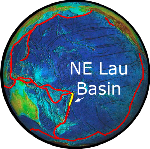
NE Lau Basin:
The Lau Basin is home to the Earth's highest subduction rates and fastest-opening backarc basin, which results in one of the Earth’s most densely populated areas of submarine volcanism and hydrothermal activity. Exploratory expeditions using water column sensors and near bottom surveys using a towed camera and a deep-diving autonomous vehicle in 2008-2011 discovered and mapped numerous sites of hydrothermal activity. Information from these cruises provided information used in site selection for the Submarine Ring of Fire 2012 expedition in September 2012, which led to new discoveries.
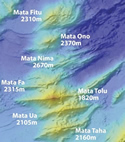 2017 Expedition: ROV Dives on YouTube!
2017 Expedition: ROV Dives on YouTube!
Watch EOI Scientists aboard the R/V Falkor with ROV SuBastian recorded in full on YouTube from November 10-December 17, 21 dives in total:
FK171110 Underwater Fire Expedition Playlist from Schmidt Ocean.
More details about the expedition at Schmidt Ocean Institute's:
"Underwater Fire: Studying the Submarine Volcanoes of Tonga"
Click the map for a larger version of the volcanoes explored on this expedition.
Expedition reports: 1) Without dive logs, 198 pages: pdf | Word (18mb|86mb)
2) With dive logs, 644 pages: pdf | Word (31mb|88mb)
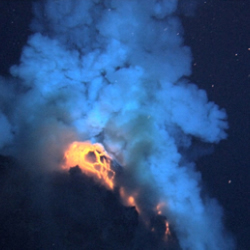 |
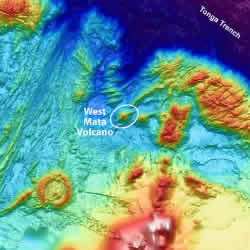 |
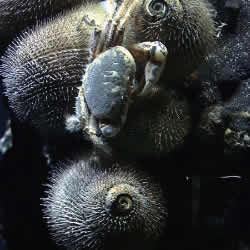 |
| Pillow lava erupts from Hades Vent at West Mata volcano. | Location of West Mata Volcano in the NE Lau basin. | Crab and gastropod on active chimney at Mata Tolu. |
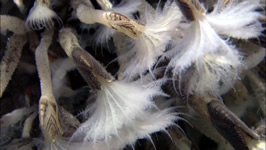 |
| Stalked barnacles feeding. (Click for video). |
Video Collection:
EOI's YouTube collection of videos from NE Lau Basin
Click here for YouTube video of West Mata eruption discovery in 2009.
Other Multimedia available for Lau Basin. (videos & images for download).
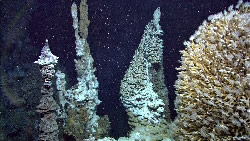 |
Hydrothermal chimneys at Mata Ua, QUEST dive 328. |
2012 expedition:
September 2012 - R/V Revelle
This expedition used the MARUM QUEST 4000 remotely operated vehicle (ROV) to conduct seafloor investigations at multiple sites on the northernmost spreading centers, magmatic arc and back-arc regions of the northern Lau Basin. The nine sites explored on the 12 dives with QUEST 4000 discovered many new hydrothermal vent sites, with unique ecosystems, and several new species of chemosynthetic fauna. A total of 164 samples on 12 dives of various types were obtained with QUEST 4000 (65 Biology, 52 geology, 27 vent fluid chemistry and 20 vent fluid gas tights).
Discoveries made during this cruise are described in more detail at the 2012 Cruise website and in the 2012 Cruise Report (pdf).
See the video highlights from the expedition on the 2012 Expedition YouTube playlist.
2010 expeditions:
December 2010 - R/V Kilo Moana
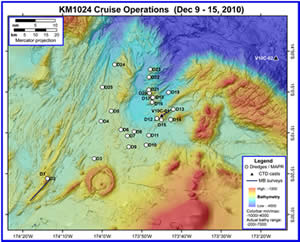 Cruise KM1024 aboard the R/V Kilo Moana in Dec 2010 was a short (7 day), targeted cruise that focused almost entirely on bottom sampling of volcanic landforms in the NE Lau basin via dredging . Water column properties (temperature, pressure, optical backscatter, and oxidation reduction potential) were measured during each dredge with a PMEL MAPR (Miniature Autonomous Plume Recorder). Seafloor mapping and CTD casts were conducted as well. It was the second expedition to the NE Lau Basin in 2010, continuing exploration of the region and building directly upon observations made during a May 2010 cruise (KM1008) and two earlier R/V Thompson cruises, TN227 (Nov 2008) and TN234 (May 2009). The goal of KM1024 was to retrieve rock samples from as many of the apparently active and recently active volcanic features in the area as possible for shore-based petrologic and rock geochronologic studies. Twenty five of twenty seven planned dredges were executed over 4.5 days, each recovering rock samples, nearly all of them fresh and relatively young. (full summary)
Cruise KM1024 aboard the R/V Kilo Moana in Dec 2010 was a short (7 day), targeted cruise that focused almost entirely on bottom sampling of volcanic landforms in the NE Lau basin via dredging . Water column properties (temperature, pressure, optical backscatter, and oxidation reduction potential) were measured during each dredge with a PMEL MAPR (Miniature Autonomous Plume Recorder). Seafloor mapping and CTD casts were conducted as well. It was the second expedition to the NE Lau Basin in 2010, continuing exploration of the region and building directly upon observations made during a May 2010 cruise (KM1008) and two earlier R/V Thompson cruises, TN227 (Nov 2008) and TN234 (May 2009). The goal of KM1024 was to retrieve rock samples from as many of the apparently active and recently active volcanic features in the area as possible for shore-based petrologic and rock geochronologic studies. Twenty five of twenty seven planned dredges were executed over 4.5 days, each recovering rock samples, nearly all of them fresh and relatively young. (full summary)
2010 KM1024 Cruise Report (pdf)
April/May 2010 - R/V Kilo Moana
The main objective of this expedition to the NE Lau Basin was to continue exploration of the region based on findings from the two previous cruises. The operational tools utilized were the CTD-rosette system and a towed camera system. During the 13 day cruise, 24 hydrocasts and 9 camera tows were conducted. One mooring was also deployed and the a new acoustic glider was successfully tested.
More information is available on the 2010 Cruise Blog and in the
2010 KM1008 Cruise Report (pdf).
2009 expedition:
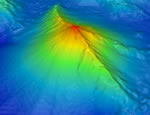 3D image of West Mata (click for full-size) |
Discovery of NE Lau Basin eruptions
This was a “rapid response” expedition as a follow-up to the 2008 expedition that discovered evidence in the water-column for two active eruptions in the NE Lau Basin. The 2009 expedition was conducted on R/V Thompson using ROV Jason, and confirmed both eruptions. The one at the NE Lau spreading center was over, but the other at West Mata Volcano was still on-going and ROV Jason documented spectacular eruptive activity at West Mata Volcano,by far the deepest submarine eruption ever witnessed.
More information about this cruise is available on the 2009 Cruise Blog, the NOAA Ocean Explorer NE Lau Response Cruise website, on the EOI NE Lau multimedia page, and in the 2009 Cruise Report (pdf).
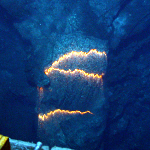 | Lava tube erupting. |
View NOAA Press Release,
View video of West Mata erupting on YouTube.
Chief Scientist Joe Resing describes submarine eruption at West Mata (University of Washington News, 12/17/09)
2008 expedition:
The 2008 Expedition to the NE Lau Basin searched for hydrothermal activity in the region by conducting water-column plume surveys. The expedition also conducted bathymetric mapping of the seafloor using multibeam sonar in areas where high resolution maps did not exist. The primary targets were the NE Lau Spreading Center (NELSC) , the Mangatolo Triple Junction (MTJ, also called the Kings Triple Junction), and the large caldera named Volcano O. More information about this cruise is available on the 2008 Cruise blog and in the 2008 Cruise Report (pdf).
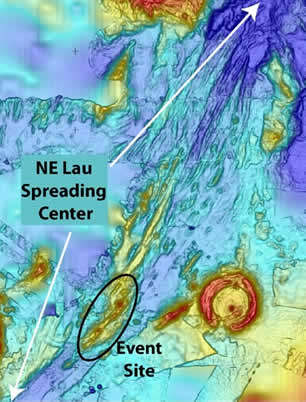 Location of the plumes discovered on the Lau Spreading Center during the 2008 expedition. (click image for larger view) |
Blog post from November 21, 2008:
Voyage TN227 of the R/V Thompson is presently conducting seafloor mapping and water-column plume surveys in the NE Lau region. We are currently over the NE Lau Spreading Center at ~15 deg 24’S, 174 deg 15’W. We have found that the water column over this back-arc spreading center is populated with an unusual suite of spectacular plumes at depths ranging from 1400 m up to 700 m below the sea surface. Some of
our water column profiles detected over 5 distinct hydrothermal plume layers, and the shallowest of these plumes is over 600 m above any local topography. Furthermore the plumes are characterized by intense light scattering anomalies, high Eh signals, and in some cases very high concentrations of dissolved hydrogen. This represents a considerable increase in activity compared to the previous study conducted here on the R/V Kilo Moana in 2004 [German et al., g-cubed, 2006], and a suite of plume surveys conducted using IMI30 and MAPRs in July 2008. Based on our collective experience, these plumes have the physical and chemical characteristics associated with seafloor eruptive activity. During the remaining 6 days of this expedition, we plan to continue surveying the region and attempt to localize the source of this unusual activity. We had considered deploying Dan Fornari's camera system, which is also on board, but not all of the necessary components are on the ship. We believe The RIDGE community should consider this site as a focus for future Time Critical Studies activities, especially in conjunction with ship operations supporting the Lau ISS.
More Information:
Link to PMEL publications from Lau Basin Expeditions
